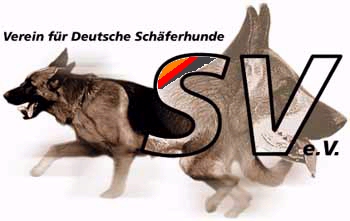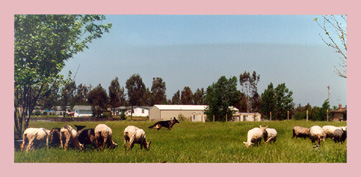
The Verein für Deutsche Schäferhunde has fostered
the herding tradition since the beginning of the organization. Herr Max
von Stephanitz exhorted members of the now world-wide body to always return
to the roots of the breed if they wanted to understand and develop their
dogs to their fullest capabilities. Here we have presented a very short
account of the beginnings of the tending dog.
Herding Dogs Past and Present
by Ann Garner
As early as the fourteenth century, with the firm establishment of the Saxon farming system on the Continent and in the crop-growing areas of England, the sheep tending dog became an essential tool in the service of agriculture.
Each Saxon manor was an extensive holding that included lands that would produce most of the necessities of life: woodlands, orchards, vineyards, waterways, market roads, grain fields and vegetable patches. There was no fencing around any part of the manor before the 1800s in England and in Germany, there is still not much fencing in the intensive agricultural areas. Therefore, in modern Germany, there is still a need for a sheep tending dog that serves the same purposes as the dogs of medieval times, namely: to provide a "living fence" to control the column of sheep as it follows the shepherd through open countryside and to hold the sheep on their assigned grazing area and to ward them off the nearby crops.
The Saxon manor farming system required that a certain number of vegetable or grain-growing patches lie fallow (unplanted) each season. The fallow patch of ground supported stubble in late Summer and grass grew on it the following Spring. The stubble and grass were the only legal forage that the farm provided for the sheep. The tending dog took his sheep through the actively growing vegetable and grain patches without the sheep pilfering snacks as they passed. The dog actively patrolled the narrow column of a few hundred sheep and then settled them on the fallow plot. Nowadays, the herd is up nearer a thousand head, a real handful for two dogs.
We know the approximate size of most of those Saxon farm plots or patches, because we still have a unit of measure in modern English which relates to their size: furlong. A furlong is the length that a draft animal can pull a heavy plow in a straight line without needing to stop, turn and relieve stress from his yoke. The modern equivalent of a furlong is ~220 yards, about a 10-acre parcel.
These 10-acre parcels usually had a furrow running along two or three sides if not all four sides. Here is where the dog could work without pressuring the sheep and without damaging the crops in the adjacent patch. From about the 1500s until the late 1800s, thousands of dogs worked the borders of those fallow fields throughout Europe (and in Germany, in particular), developing into a specialized branch of the canine family.
Although the foregoing describes a German farming system which also operated in England until the Enclosure Acts in the 1800s, the work did not require a specific breed or national origin for the working dogs. If one studies nineteenth century photographs of sheep tending dogs in Germany, or if one observes the modern herding dogs of Germany, he will see dogs that look like American "Aussies," Border Collies, Bernese Mountain Dogs, Briards, Poodles, Schnauzers, Belgian Shepherds, Bouviers, and of course, like the twentieth century German Shepherd Dog. Before the 1890s, all these dogs were called German Shepherd Dogs if they worked sheep in Germany. The dogs that are not bred to a standard are now called Old German Shepherd Dogs (Altdeutscher Schaeferhund) and those that are bred to the breed standard are known as the German Shepherd Dog (Deutscher Schaeferhund).
However, even today, most herding dogs in Germany are bred for working ability only, and therefore a great many of 5000 or so sheep tending dogs presently working are "generic" in appearance. They may be called Old German Shepherd Dogs because they herd sheep in Germany, but they may look like any or all of the breeds mentioned above. As a result, we find that the sheep tending instinct is not isolated only in the genes of the breed that is called German Shepherds here in America, but is often manifest in many of the modern standard breeds named above. Blessedly, that deep-rooted instinct does appear with great frequency in the modern standard German Shepherd Dog.
References:
Max von Stephanitz, The German Shepherd Dog in Word and Picture
Karl Hermann Finger, Hirten und -Hutehunde
Sir Albert Howard, The Soil and Health
Ulf Kintzel, personal communication
German Shepherds and Strip Grazing
.........................the story of our meadow project

Azraq works on the border of the graze to keep the sheep from straying into another part of the meadow
Shobeq, Azraq, Fee and Khilim are all working shepherd dogs that are
now helping me in a soil conservation/restoration project. This soil building
and revegetation project is guided by advice from soil scientists in the
U. S Department of Agriculture, from members of a California grasslands
association and from graziers with practical experience in soil building
and grazing management.
The dogs perform as living fences in a grasslands management system called
"strip grazing." They fence off the sheep from areas of open
meadow, allowing the sheep to graze and fertilize only a certain marked-off
area. Through such a program of rotational strip grazing, fertility can
be improved, weeds can be controlled and formerly grazed sections of grass
can re-grow to be grazed again in a few days.
Our small flock of about 40 head of hardy crossbreds will be controlled
by a trained dog while the young apprentice dog learns to tend sheep in
this ancient method of sheep-raising and grassland management. This same
method is still used in Germany, whence it came to England with the Saxons
and was used until a time just prior to the Industrial Revolution.
This system is also appropriate on a small farm with grasslands that need
to be conserved or restored. In fact, many small farms have divided the
whole property into small paddocks just large enough for a day or two of
grazing. For our meadow plot, this old-world system offers a viable alternative
to cross-fencing the grassland into small grazing paddocks, each of which
must have its own shade and water. Your meadow begins to look like a stockyard
in that situation.
Tending dogs -- our Herdenhunde vom Weiher -- serve as the paddock fences
or pasture dividers by moving the sheep to the assigned grazing area, keeping
them in only that area while they graze, then moving them back to the sheepfold
for water or rest.
If you have questions, please choose one of the options below to contact
me.
Email Ann at Herdenhunde vom Weiher
Sign our guestbook
Return to Home Page
This page hosted byGet your ownFree Home Page